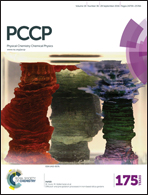Switching adsorption and growth behavior of ultrathin [C2C1Im][OTf] films on Au(111) by Pd deposition
Abstract
Combining in vacuo deposition of ultrathin ionic liquid (UTIL) films with angle-resolved X-ray photoelectron spectroscopy (ARXPS), we demonstrate that by deposition of submonolayer amounts of Pd onto Au(111) the initial growth mode of the ionic liquid (IL) 1-ethyl-3-methylimidazolium trifluoromethanesulfonate ([C2C1Im][OTf]) can be switched from three-dimensional (3D) to two-dimensional (2D) growth, that is, from non-wetting to wetting. On clean Au(111), pronounced 3D growth occurs on top of an initially formed 2D wetting layer with cations and anions next to each other in a checkerboard arrangement. After pre- or postdeposition of only 0.7 ML Pd, two-dimensional layer-by-layer growth is found, which is attributed to strong attractive interactions between [C2C1Im][OTf] and surface Pd. For Pd post deposition onto the IL, the ARXPS data revealed particularly strong interactions between the dialkylimidazolium cation and Pd atoms, which considerably reduce the regular surface alloying of Pd with the Au substrate stabilizing Pd at the metal surface. In the context of heterogeneous catalysis using the SCILL (solid catalyst coated with ionic liquid layer) concept, these results directly provide a possible explanation on the molecular level for the beneficial influence of the IL layer in case of heterogeneous metal alloy catalysts.
![Graphical abstract: Switching adsorption and growth behavior of ultrathin [C2C1Im][OTf] films on Au(111) by Pd deposition](/en/Image/Get?imageInfo.ImageType=GA&imageInfo.ImageIdentifier.ManuscriptID=C6CP04938A&imageInfo.ImageIdentifier.Year=2016)

 Please wait while we load your content...
Please wait while we load your content...